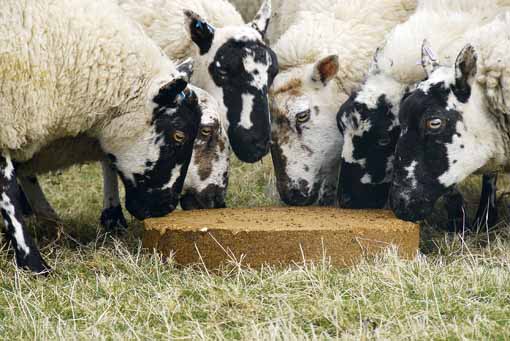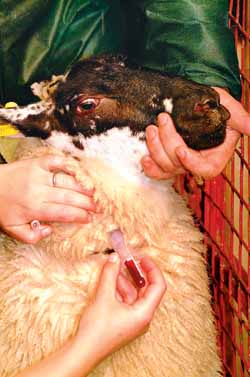Hit and miss minerals having adverse affect on sheep health

Providing ‘hit and miss’ mineral supplement requirements to sheep could be having adverse effects on fertility and performance, a recent trial has revealed.
Vets involved in a blood-profiling trial in upland and lowland flocks in Cumbria believe many sheep farmers are wasting money on free-access minerals because intakes are haphazard and often fail to supply the trace elements required.
And farmers have taken a positive attitude and say the outcome of the trial has made them question flock management practices that have been “blindly” followed purely as a matter of routine.
One farmer who treats ewes with boluses to provide the precise trace element needs of his Swaledale flock – instead of providing free access minerals – says that while there was a slight improvement in fertility, he attributes the “vigour” of ewes and lambs throughout the season to the new approach to mineral supplementation.
Vet James Frayne of Millcroft Vets in Cockermouth, who undertook the blood sampling, says as sheep values have increased it is now even more important for farmers to recognise the role played by trace elements.
“Vets have never been big fans of just sticking out mineral buckets and hoping for the best. Sheep farmers seem to love them because they’re hassle-free, but intakes are always variable.
“Some ewes take more than others, which in itself is a failure of the system, but most importantly the free-access option doesn’t identify what trace elements the ewes really need – and that impacts on the health and performance of the ewes and their lambs,” says Mr Frayne.
The Cumbria trial, organised by The Farmer Network Livestock group through the North West Livestock Programme, took blood samples from six ewes from flocks at four farms in west Cumbria. The primary test was to check for levels of copper, cobalt and selenium.
Mineral deficiency problems
“These are essential trace elements for sheep health,” says Mr Frayne. “Cobalt deficiency causes problems in growing lambs, while a shortage of selenium leads to white muscle disease with lambs appearing stiff and weak. Poor performance and lower fertility are also signs of low levels of selenium.
“The classic symptom of copper deficiency is swayback in lambs caused by underdevelopment of the spinal nerves, but lower growth rates and poor fertility can also be caused by ewes being short of copper,” adds Mr Frayne.
But he acknowledges that while most sheep farmers believe copper deficiency is rare, it’s the risk of copper being “bound-up” by other heavy metals present that is more widespread.
“Thiomolybdate toxicity in the soil binds up copper through the presence of other elements such as sulphur and iron. The copper becomes unavailable to ruminant animals because it passes straight through the rumen. It’s more often seen in lowland flocks where grassland receives higher fertiliser applications and is less common in fell sheep.”
Selenium deficiency causes white-muscle disease in lambs – pale, weak, non-functional muscles that prevent lambs from standing. Lambs deprived of selenium will grow less efficiently and have a weaker immune system, while ewes will be less fertile.
Although cobalt deficiency wasn’t a major feature of the Cumbria trial, Mr Frayne says when it does occur it hits the development of growing lambs.
“The major reason that lambs can be deficient in cobalt isn’t that there is insufficient cobalt available to them, but that scouring caused by a heavy worm burden reduces the rate of natural cobalt absorption. It’s known as “pine”, which is a disease of weaned lambs that appear lethargic with poor wool.”
Sub-clinical mineral deficiency
But he says his biggest concern among vets is the high level of sub-clinical mineral deficiency that exists in flocks and that farmers remain unaware of.
“It’s widely assumed that free-access minerals are doing their job, and while there may be no major health or performance issue that makes a farmer question any possible mineral deficiency, it’s very likely that his sheep are short of something and that their performance and health is being affected.
“Lower flock performance is often being accepted as the norm when correct mineral supplementation to meet the precise needs of the ewes could make a significant improvement,” he adds.
Blood profile results from the four farms tested
 Farm 1: Selenium levels were normal but sheep showed some evidence of long-term exposure to thiomolybdate with copper bound up (there had been no copper given within four to six weeks of testing).
Farm 1: Selenium levels were normal but sheep showed some evidence of long-term exposure to thiomolybdate with copper bound up (there had been no copper given within four to six weeks of testing).
Farm 2: Selenium levels were high following a summer worming treatment but there was strong evidence of thiomolybdate toxicity.
Farm 3: Selenium levels were high but there was evidence of thiomolybdate toxicity.
Farm 4: Selenium levels were low; there was slight evidence of thiomolybdate toxicity but a definite copper deficiency.
Treatments
It’s essential to take blood samples from sheep that are representative of the flock in general terms of age and physical condition – one for every 100 ewes was the sampling rate in the trial.
“Drenches containing cobalt and selenium only provide a short-term effect. Copper is available in gelatine capsules but doesn’t give a long duration of cover.
“Boluses are the most effective for sustained mineral release, but it’s important for farmers to have discussions with their vet to assess precisely what minerals are needed. Supplementing with copper when it’s not needed can be very dangerous,” warns Mr Frayne.
Case study: Andrew Nicholson, Cockermouth
Andrew Nicholson runs a flock of 1,600 ewes – Swaledale, Herdwick and Texel x Mules – at Lorton near Cockermouth. He blood tested a sample from a flock of 450 Swaledale ewes and the results surprisingly showed high levels of selenium were present – almost to the point of hampering fertility – even though they hadn’t been supplemented.
“Blood tests also showed the flock was suffering from thiomolybdate toxicity. The copper was being locked up, so by giving a bolus containing copper we managed to overcome the problem by providing even more of it,” said Mr Nicholson.
He admits that it was “all too easy” to settle into routines of flock management – and that includes providing free-access minerals without questioning their real benefit.
“We knew that fell ewes were often reluctant to use the mineral licks but it’s something you learn to live with without looking at the real consequences.
“Meeting the ewes’ precise mineral needs through a bolus made a big difference. We were getting about 650 lambs from the 450 Swaledale ewes in the trial but I’m convinced we can improve on that now we’re correctly providing the right trace elements.
“But there’s been a general improvement in the health of the flock. Lambs were more vigorous and grew much better all summer and were certainly more able to cope with the tick problems we have on that fell.
“With current sheep values, the 50p cost of a bolus is easily justified. We gave the ewes a bolus just before lambing and this autumn treated them soon after the tups were turned out. It’s an added cost, but better to have spent it and saved lambs rather than not and suffer the cost of lamb losses and poorer performance,” says Mr Nicholson .
